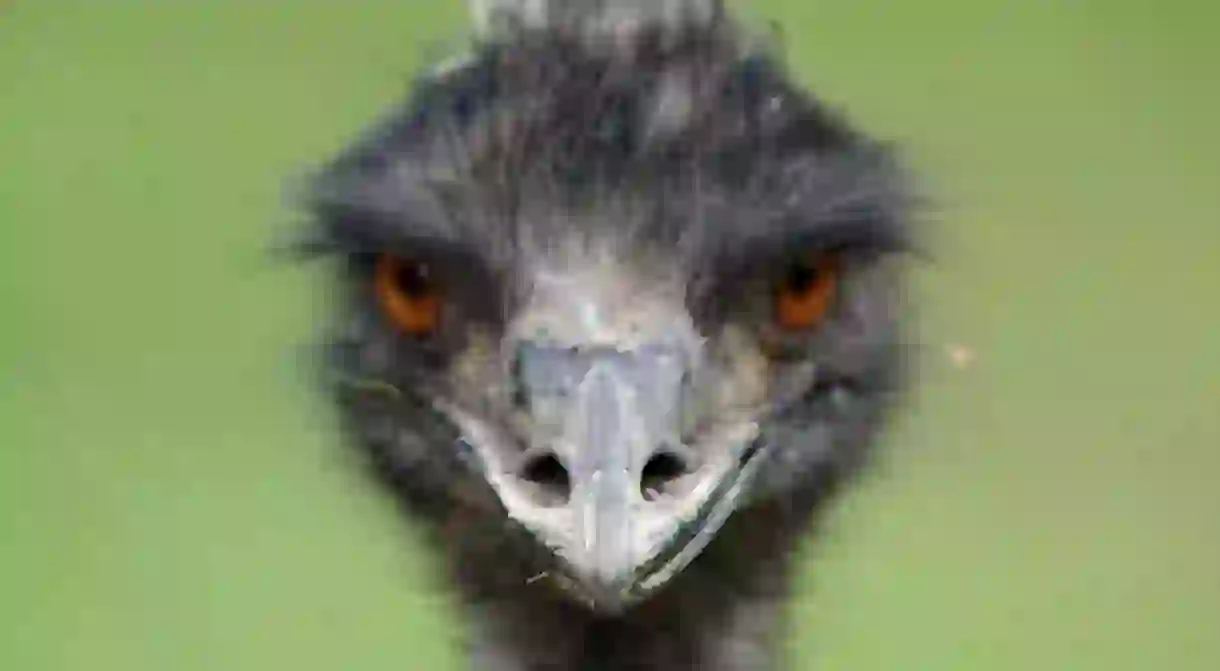Emu: 11 Facts About Australia's National Bird

It’s tall. It’s funny looking. It’s got fluffy feathers. No, not Big Bird from Sesame Street—we’re talking about the emu, the avian emblem of Australia. Here’s 11 fun facts you might not know about Australia’s national bird.
Their name is Latin for ‘fast-footed New Hollander’
The emu’s scientific name is ‘Dromaius novaehollandiae’, combining a Greek word meaning ‘racer’ and the Latin term for ‘New Holland’, an early colonial title for Australia. So the full Latin translation? Fast-footed New Hollander. No one’s certain about where ‘emu’ came from, but it’s believed to derive from an Arabic or Portuguese word that explorers used to describe a relative of the emu, the cassowary.

They’re the second biggest bird on earth
The largest emus can grow up to 1.9m (a tick over six foot) in height, bigger than every other bird on the planet besides its ratite cousin, the ostrich, which regularly ranges between 2.1 and 2.8m in its native Africa. Emus normally weigh around 35kg and females are slightly larger because of their big backside, designed for egg laying.
The male incubates the eggs
Mrs Emu is the one who lays the clutch of eggs, but Mr Emu is responsible for the lengthy incubation period. The 9x13cm eggs turn a rich shade of green over the eight weeks their daddy sits on them, over which time the male doesn’t eat, drink or defecate (losing a third of his body weight), and only really moves to turn the eggs 10 times a day.

They’re significant to Indigenous communities
The emu appears in many different Dreaming stories told by Australia’s diverse Indigenous communities, including a common creation story about how the sun was generated by an emu egg in the sky. Some Indigenous groups also caught the flightless birds with sophisticated traps and spears, using the meat for food, the fat for medicine, the bones for tools, and the feathers for decoration. The emu is a common motif in Indigenous art and ceremonies.
They’re seriously speedy
Emus’ wings might be vestigial, but that doesn’t stop this flightless bird from being able to seriously motor. Three strong toes on each foot, ‘calf’ muscles in their lower legs and a specialised pelvic structure helps the emu sprint at speeds around the 50km/h mark, taking strides that are almost three metres long. That pace would make Usain Bolt look like a slouch.

They can’t walk backwards
It’s often stated that the emu and the kangaroo were chosen to appear on Australia’s Coat of Arms because they can’t walk backwards, making them suitable symbols of progress. Of course, most animals don’t walk backwards, including the kangaroo, whose tail gets in the way, and the emu, apparently because their knees don’t bend the right way. But hey, that ‘moving forward’ symbolism still makes for a good story.
They appear on Australia’s 50 cent coin
The humble emu is spotted with its mate, the red kangaroo, on this silver 12-sided coin, as well as on its lonesome on a series of postage stamps since 1888. The Light Horse units of the Australian Defence Force have also worn emu feather plumes in their hats since the late 19th century, a tradition that continues today.

Humans fought a war against them … and lost
Speaking of the military, the national bird found itself in the crosshairs of Australia’s armed forces in 1932, but somehow emerged victorious. The Royal Australian Artillery deployed troops to the wheatbelt region of Western Australia where huge populations of emus were destroying farmers’ crops, and despite tens of thousands of rounds of ammunition, the army failed to halt the march of the emu over a two-month campaign.
You can eat them
The poor emus that did encounter a premature end were carrying plenty of iron-rich red meat—roughly 14 kilos per bird, according to emu farmers. Emus aren’t widely farmed (or eaten) in Australia but there is one pub in Sydney’s historic Rocks precinct that cooks up a Coat of Arms pizza, which combines emu and kangaroo with bush tomato, capsicum and lemon myrtle mayonnaise.

Plenty of sports teams are named after them
As you’d expect from the national bird of such a sports-mad nation, the emu lends its name to an array of sporting teams in Australia. The under-19s national basketball team, the second-string side on rugby league Kangaroo tours, Penrith’s Shute Shield rugby union outfit and countless smaller community clubs wear the emu on their uniforms.
You can spot them all over the place
Emus are found all over Australia, both in arid inland areas as well as along the coast, but they’re most common in the southeast corner of the country. Tower Hill in rural Victoria is a noted hotspot, while plenty of zoos offer emu-feeding experiences, including Cleland Wildlife Park in Adelaide.














